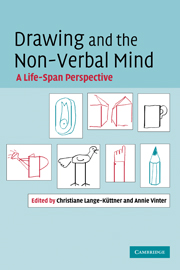Book contents
- Frontmatter
- Contents
- Contributors
- 1 Contemporary enquiries into a long-standing domain: Drawing research
- Part I Self, symbols and intention
- 2 Understanding reflections of self and other objects
- 3 Drawing production, drawing re-experience and drawing re-cognition
- 4 Style and other factors affecting children's recognition of their own drawings
- 5 Children's understanding of the dual nature of pictures
- 6 Pictorial intention, action and interpretation
- Part 2 Syntax, space systems and projection
- Part III Aging, blindness and autism
- Index
- References
3 - Drawing production, drawing re-experience and drawing re-cognition
Published online by Cambridge University Press: 22 September 2009
- Frontmatter
- Contents
- Contributors
- 1 Contemporary enquiries into a long-standing domain: Drawing research
- Part I Self, symbols and intention
- 2 Understanding reflections of self and other objects
- 3 Drawing production, drawing re-experience and drawing re-cognition
- 4 Style and other factors affecting children's recognition of their own drawings
- 5 Children's understanding of the dual nature of pictures
- 6 Pictorial intention, action and interpretation
- Part 2 Syntax, space systems and projection
- Part III Aging, blindness and autism
- Index
- References
Summary
Referring to the literature concerned with recognition of drawings, Ross suggests that self-drawings may be seen as advanced forms of the mirror test of self-recognition, and, as such, are likely to reveal the content of self-knowledge. She explores this proposition through two instructive experiments carried out with children aged 3 to 9 years. The first study establishes that the quality of self-drawings as well as the ability to recognize one's own drawings are related to self-awareness as measured by mirror recognition. The second experiment offers a deeper understanding of these relationships and shows that drawing recognition constitutes an act of self-recognition in itself. In this experiment, besides producing drawings, children were asked either to trace over their peers' drawings with a pencil (a drawing task involving a certain level of self-engagement) or to examine them visually while also hearing a verbal description. Whereas traced drawings were recognized as such after sizeable delays, those only visually examined were not. Ross concludes that ‘children's retrospective analysis of their own drawings has the potential to reveal their self-awareness’.
the maxim ‘Children draw what they know, rather than what they see’ is a formative and recurring topic in the study of children's art. This characteristic, implying a communicative or expressive function for children's drawings, has led many to reason that early artwork can be used to study cognitive development.
- Type
- Chapter
- Information
- Drawing and the Non-Verbal MindA Life-Span Perspective, pp. 42 - 62Publisher: Cambridge University PressPrint publication year: 2008
References
- 5
- Cited by



